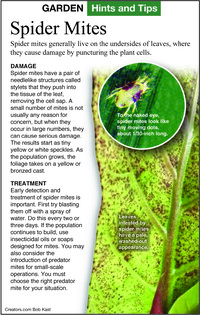Q: As I was bringing in one of my houseplants for the winter, I noticed that it has spider mites. I put it in a room by itself and have been spraying it with rubbing alcohol. It seemed to be working, but then the mites came back. What works the best on spider mites?
A: Spider mites are very small and hard to see. It would take 50 of them in a line to make an inch. The nymph stages are even smaller. You may need to use a magnifying glass to see them. Rap a leaf onto a piece of white or black paper, and you might be able to see small specks moving around.
Spider mites do cause damage that is visible. They suck out a small amount of green leaf tissue, and that causes tiny brown spots. With enough feeding, the whole leaf starts to turn brown. They also live up to the spider part of their name when they create webs between leaves.
Before we can do a treatment, we need to understand what they are. They are in the arachnid family, not the insect family. There are lots of mite species. Some create galls on ash tree flowers; some create red galls on maple leaves; and some of them are predatory on other mites. The two-spotted spider mite is common on houseplants. If you look at mites, they have eight legs, no antennae and only one body section. Insects have six legs, two antennae and three body sections. Spider mites suck out a lot of plant liquids that are very low in nutrients. They need to excrete the liquids, and they do some of that by sweating, so they need dry air with low humidity to thrive. Thriving in dry, low-humidity air is what makes them such a pest indoors. Most homes have very low humidity during the winter, and plants are clustered close together with no rain to wash the mites away.
Another thing that makes spider mites thrive is that their life cycle can be completed in less than a week. Their population can double every week. You need to take an outbreak seriously. They spread to new plants by walking over if the leaves are touching. They can float short distances if the wind or heater vent air blows them to a new plant. They can ride on people and pets who bump an infested plant.
The first thing you should do when you find an infested plant is to quarantine it. You might be able to prune off a single heavily infested leaf or branch. If the plant is small enough, you can run it under the sink or shower to wash a lot of the mites away. Be sure to get the underside of leaves, as that is where they feed. If the plant has large leaves, such as a rubber tree or fiddle-leaf fig, you can wipe the leaves with a damp cloth. Increasing the household humidity to over 50% may not be feasible, but if you can do it, it will help slow the population growth. Misting doesn't work if the overall humidity is low because the mist evaporates, and the humidity stays low.
Insecticidal soap and horticulture oils such as Neem oil that specifically state on the label that they treat mites work well. They may not kill all of the eggs, so you may need to reapply in three days, because that is how fast the eggs hatch. If you wait a week, the eggs will have hatched and the new adults will have laid new eggs, and you will have to start over again.
Some insecticides will state on the label that they work on mites, so follow the directions on the label. Systemic insecticides that say they work on mites are a long-term solution because the chemicals may move too slowly, and not into every part of the plant, while the mite population doubles every week.
The takeaway here is that spider mites are serious pests, especially indoors over the winter, but they can be controlled with proper use of products that say on the label that they treat mites.
Email questions to Jeff Rugg at [email protected]. To find out more about Jeff Rugg and read features by other Creators Syndicate writers and cartoonists, visit the Creators Syndicate website at www.creators.com.DIST. BY CREATORS.COM







View Comments